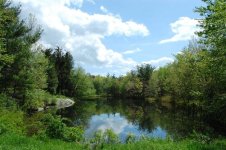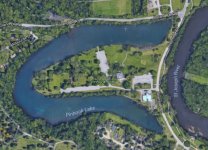Moss -when you & I were 14-15 years old federal & state management agencies were just becoming familiar with rotenone. And spiny-ray fish are the very toughest kind to try to kill when poisoning lakes. Evolution has prepared spiny-ray fish to live in low oxygen environments. Salmonids - trout and salmon types - do best in highly oxygenated waters and can't tolerate low-oxygen environments.
Yep, that's what they used.... rotenone. I was in Boy Scouts, so I did some community service and merit badge work with the DNR. The lake is an oxbow lake, about a mile long. Used to be the river, but in the depression, the WPA cut it off from the river and diverted the channel across the oxbow and put in a road and park in inner bend. That was low ground. The outer bend was high ground. We lived on a 90' escarpment overlooking the lake and low park. We had about 150 steps going down to the lake. The lake had all species of river fish. Small and largmouth bass, panfish of all species, several species of catfish, northern pike, some other kind of pike, crappie, perch, carp, longnose gar, bullheads, and up to 4 pound goldfish. Probably a few more that I can't remember.
Anyhow, we'd catch really big bass and crappie, and lots of 8" bluegills. BIG channel cats. Just a great place to grow up.
For some reason, the DNR decided that there were too many roughfish in the lake (carp) and decided they were going to kill the entire lake in the fall, let it sit empty all winter, then restock it in the spring.
So they came out the day before and tried to electroshock the lake and catch as many large bass as they could for their state fish hatchery. They didn't get too many, as pretty much the entire shoreline was downed trees and they couldn't maneuver their boat in to get the large breeding sized fish.
The next day, they took a johnboat with a barrel on it, mixed up a batch of rotenone, and hooked a tube from the boat's bailer to the barrel and out the back of the boat. Then they made two passes, up, then down the lake. You could see the milky solution go out behind the boat.
Then they waited....
I was sitting by the shore in front of our house, and about half an hour later, these itty bitty perfectly formed bluegill less than an inch long started coming to the surface. Thousands of them. It seemed, and this is no joke, that for about every 10 minutes that passed, the fish coming to the surface gained size by about an inch. So, you had inch long fish, then 2 inchers, then 3 inchers, etc.... pretty much all the species coming up after about 4-5 inch bluegills.
Well, several hours into it, the bigger fish started coming up. Then the DNR took their boat out again with barrels of fresh water and started netting the bigger bass. If you got them into fresh water, they'd snap out of it pretty quick. They kept moving the fish to a fish truck on shore that had aerators going.
They said the fish in the lake would be perfectly safe and edible for human consumption as long as they were still moving when you got them, so literally hundreds of people were standing on shore pulling fish out and putting them in pails (no 5 gallon plastic buckets back then). I took my rowboat out and got 24 largemouth over 4 pounds. The largest was about 26" and weighed 8 pounds. Sad to say the largest bass I ever caught in my life to this day, was with a net!
Also got about 100 bluegills. My grandpa and I cleaned them all up and froze them.
They pulled a 4' gar out of there, as well as some over 3' pike, too. And dinner plate sized crappie.
Towards the end of the day, the carp were still not dead. I pulled so many carp out into my boat, that I had about an inch of blood in the bottom by the full 12' long. It looked like some kind of fish slaughter house. There were bunches of old ladies standing on the shore asking me for the carp, so I obliged. I remember one guy walking out into the water and grabbing handfuls of carp. They filled the bed of a pickup truck with them.
The largest carp I caught was 37", somewhere between 15-20 pounds.
By nightfall, all of the carp had come to the surface, but seemed to be gulping air. It took them a couple days to die.
For several days, depending on which way the wind blew, there was a solid wall of dead fish 10' out from the shore for about a half a mile long. Surprisingly, there was little stink.
Anyhow, in later years, it was determined that the whole thing was done at the urging of some stupid bass fishing club. The project was a complete failure. As mentioned, it was stocked with bass, bluegill and channel catfish, but the first winter after re-stocking, there was an abundance of perch, pike and crappie of edible size. So they survived. They couldn't have grown that fast in a year.
On a sad note, there used to be an abundance of softshell turtles in that lake, along with many other turtle species. There were no more softshell turtles after that. They either died or left, but I haven't seen one in there since. I know they are still in the river across the road, but not very many of them.
The whole thing was a waste of time, money, animal resources, etc... just to appease some bass fisherman.
Theses days, the lake is over-populated with stunted bluegill, lots of sub-18" bass, smaller crappie, smaller perch and some decent pike. But to my knowledge, the DNR never came back and did follow up. They basically wrecked the lake that had been a wonderful place to fish before they touched it.
Rant over. Fish out. :laughing:


